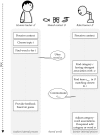Why Robots Should Be Social: Enhancing Machine Learning through Social Human-Robot Interaction
- PMID: 26422143
- PMCID: PMC4589374
- DOI: 10.1371/journal.pone.0138061
Why Robots Should Be Social: Enhancing Machine Learning through Social Human-Robot Interaction
Abstract
Social learning is a powerful method for cultural propagation of knowledge and skills relying on a complex interplay of learning strategies, social ecology and the human propensity for both learning and tutoring. Social learning has the potential to be an equally potent learning strategy for artificial systems and robots in specific. However, given the complexity and unstructured nature of social learning, implementing social machine learning proves to be a challenging problem. We study one particular aspect of social machine learning: that of offering social cues during the learning interaction. Specifically, we study whether people are sensitive to social cues offered by a learning robot, in a similar way to children's social bids for tutoring. We use a child-like social robot and a task in which the robot has to learn the meaning of words. For this a simple turn-based interaction is used, based on language games. Two conditions are tested: one in which the robot uses social means to invite a human teacher to provide information based on what the robot requires to fill gaps in its knowledge (i.e. expression of a learning preference); the other in which the robot does not provide social cues to communicate a learning preference. We observe that conveying a learning preference through the use of social cues results in better and faster learning by the robot. People also seem to form a "mental model" of the robot, tailoring the tutoring to the robot's performance as opposed to using simply random teaching. In addition, the social learning shows a clear gender effect with female participants being responsive to the robot's bids, while male teachers appear to be less receptive. This work shows how additional social cues in social machine learning can result in people offering better quality learning input to artificial systems, resulting in improved learning performance.
Conflict of interest statement
Figures











References
-
- Powers A, Kiesler S. The Advisor Robot: Tracing People’s Mental Model from a Robot’s Physical Attributes. In: Proceedings of the 1st ACM SIGCHI/SIGART Conference on Human-robot Interaction. HRI’06. New York, NY, USA: ACM; 2006. p. 218–225.
-
- Cakmak M, DePalma N, Arriaga RI, Thomaz AL. Exploiting Social Partners in Robot Learning. Autonomous Robots. 2010;29:309–329. 10.1007/s10514-010-9197-9 - DOI
-
- Sternglanz SH, Gray JL, Murakami M. Adult preferences for infantile facial features: An ethological approach. Animal Behaviour. 1977;25, Part 1:108–115. Available from: http://www.sciencedirect.com/science/article/pii/0003347277900720 10.1016/0003-3472(77)90072-0 - DOI - PubMed
Publication types
MeSH terms
LinkOut - more resources
Full Text Sources
Other Literature Sources

